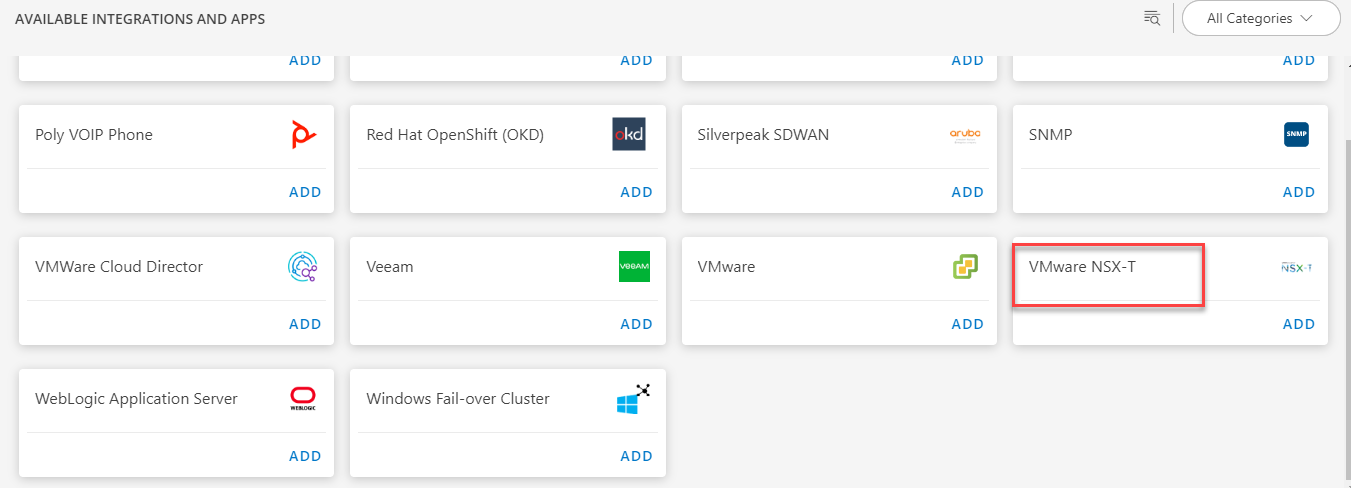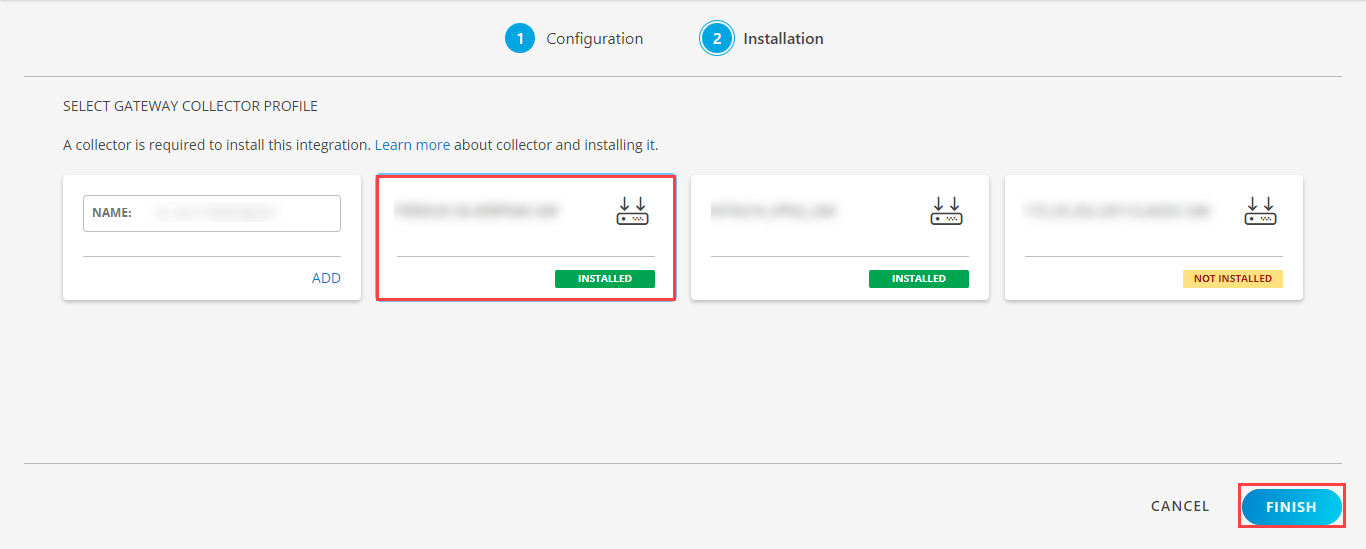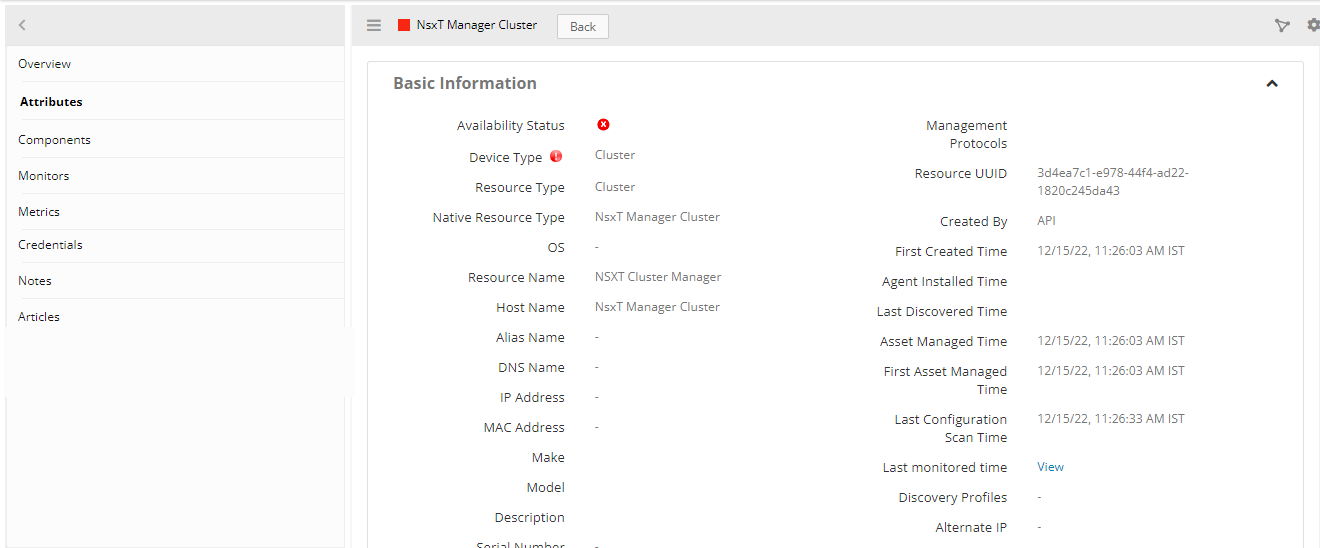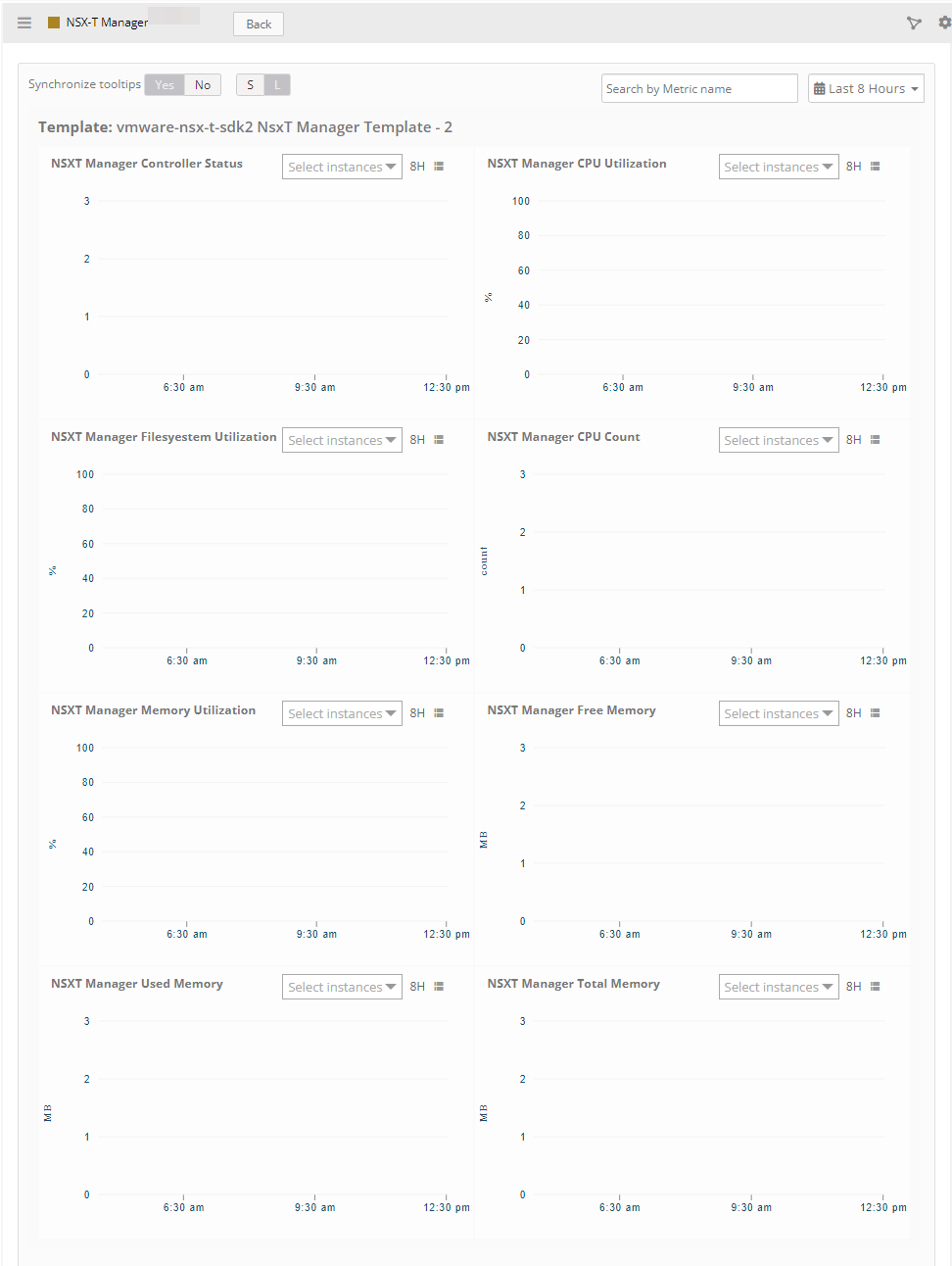| Supported Versions |
|---|
| Validated against target device |
| REST API version using 3.1.2 |
Introduction
VMware NSX-T™ Data Center provides an agile software-defined infrastructure to build cloud-native application environments. NSX-T Data Center focuses on providing networking, security, automation, and operational simplicity for emerging application frameworks and architectures that have heterogeneous endpoint environments and technology stacks.
VMware NSX
VMware NSX is a network virtualization and security platform that enables the virtual cloud network, a software-defined approach to networking that extends across data centers, clouds and application frameworks.
VMware NSX is suitable for all infrastructure types:
- Multi-cloud environments
- On-premises data centers
- Bare metal servers
- Containerized workloads
Benefits of NSX-T
The main benefit is that NSX-T can be deployed in heterogeneous environments with many different components. NSX-T is not under the confines of the vCenter deployment. You can have multiple vCenter servers and use one NSX manager as a single pane of glass for controlling your virtual network. Or, you do not have to deploy a vCenter at all. Instead, you can choose ESXi as the operating system in the NSX-T GUI, for example.
NSX-T Main Components:
The primary components of VMware NSX-T are:
NSX-T Manager: provides graphical user interface (GUI) and RESTful API for creating, configuring, and monitoring NSX-T components, such as segments and gateways.
NSX-T Controller: they are responsible for the programmatic deployment of virtual networks across the entire NSX-T architecture, and control the virtual networks and overlay transport tunnels.
NSX-T Edges: provides routing services and connectivity to networks that are external to the NSX-T deployment.
Logical Firewall: NSX-T handles traffic in and out of the network according to firewall rules.
Logical Routers (Gateways): NSX-T Gateways provide North-South connectivity so that workloads can access external networks and East-West connectivity between different logical networks.
Transport Zone: A transport zone defines a collection of hosts that can communicate with each other across a physical network infrastructure.
Prerequisites
- The OpsRamp Gateway must be installed.
Hierarchy of NSX-T resources:
NSX-T Manager Cluster
— NSX Manager (nodes)
— Edge Cluster
— Router
— Firewall
— Transport Zones
— Edge Transport Nodes (ESXi)
— Edge N/W Interfaces (Physical)
— Edge VMs
— Host Transport Nodes
— Host N/W Interfaces (Physical)
— Host VMs
— Logical Switches
Configure and install the integration
- Go to Setup > Integrations and Apps.
- Click + ADD on the INSTALLED APP page. The AVAILABLE INTEGRATIONS AND APPS page displays all the available applications along with the newly created application with the version.
Note: You can even search for the application using the search option available. Also you can use the All Categories option to search.

- Click ADD in the VMware NSX-T application.
- In the Configurations page, click + ADD. The Add Configuration page appears.
- Enter the below mentioned BASIC INFORMATION:
| Functionality | Description |
|---|---|
| Name | Enter the name for the configuration. |
| NSX-T Manager IP Address | IP address of the target. |
| Port | Port Example: By default 443 is the port value |
| Credential | Select the credentials from the drop-down list. Note: Click + Add to create a credential. |
Notes:
- By default the Is Secure checkbox is selected.
- App Failure Notifications: if turned on, you will be notified in case of an application failure that is, Connectivity Exception, Authentication Exception.
- In the RESOURCE TYPE section, select:
- ALL: All the existing and future resources will be discovered.
- SELECT: You can select one or multiple resources to be discovered.
- In the DISCOVERY SCHEDULE section, select Recurrence Pattern to add one of the following patterns:
- Minutes
- Hourly
- Daily
- Weekly
- Monthly
- Click ADD.

- Now the configuration is saved and displayed on the configurations page after you save it. From the same page, you may Edit and Remove the created configuration.
- Click Next
- In the Installation page, select an existing registered profile, and click FINISH.

The application is now installed and displayed on the INSTALLED INTEGRATION page. Use the search field to find the installed application.
Modify the Configuration
See Modify an Installed Integration or Application article.
Note: Select the VMware NSX-T application.
View the VMware NSX-T details
The VMware NSX-T integration is displayed in the Infrastructure > Resources > Cluster. You can navigate to the Attributes tab to view the discovery details.

The NSX-T Manager(nodes), Edge Cluster and Transport Zones are displayed under Components:

The Metrics tab to view the metric details for VMware NSX-T

Supported metrics
| Native Type | Metric Name | Metric Display Name | Units | Description |
|---|---|---|---|---|
| NsxT Edge Cluster | nsxt_edgecluster_Status | NSXT EdgeCluster Status | — | Returns the aggregated status for Edge Cluster Possible values: Up, Down, Degraded, Unknown. |
| NsxT Edge Physical Network Interface | nsxt_edgenode_physicalinterface_AdminStatus | NSXT EdgeNode Physical Interface Admin Status | — | EdgeNode Network Interface Admin Status. Possible values: Up, Down, Degraded, Unknown. |
| nsxt_edgenode_physicalinterface_LinkStatus | NSXT EdgeNode Physical Interface Link Status | — | EdgeNode Physical Interface Link Status. Possible values: Up, Down, Degraded, Unknown. | |
| NsxT Firewall | nsxt_firewall_RuleCount | NSXT Firewall Rule Count | count | Number of Rules associated with a Firewall. |
| nsxt_firewall_SectionCount | NSXT Firewall Section Count | count | Number Of sessions within a firewall returns. Total Number Of Sections available for a Firewall. | |
| NsxT Host Physical Network Interface | nsxt_hostnode_physicalinterface_AdminStatus | NSXT HostNode Physical Interface Admin Status | — | HostNode Network Interface Admin Status. Possible values: Up, Down, Degraded, Unknown. |
| nsxt_hostnode_physicalinterface_LinkStatus | NSXT HostNode Physical Interface Link Status | — | HostNode Network Interface Link Status. Possible values: Up, Down, Degraded, Unknown. | |
| NsxT Logical Switch | nsxt_logicalswitch_DroppedReceivedPackets | NSXT LogicalSwitch Dropped Received Packets | count | Number of received packets received by Logical Switch. |
| nsxt_logicalswitch_DroppedTransmittedPackets | NSXT LogicalSwitch Dropped Transmitted Packets | count | Number of transmitted packets dropped by Logical Switch. | |
| nsxt_logicalswitch_FullyRealizedSwitchCount | NSXT LogicalSwitch Fully Realized Switch Count | count | Number of Logical switches in fully realized state | |
| nsxt_logicalswitch_LogicalPortCount | NSXT LogicalSwitch LogicalPorts Count | count | Number of Logical ports associated with a logical switch | |
| nsxt_logicalswitch_TotalReceivedBytes | NSXT LogicalSwitch Total Received Byttes | bytes | Number of transmitted packets dropped by Logical Switch | |
| nsxt_logicalswitch_TotalReceivedPackets | NSXT LogicalSwitch Total Received Packets | count | Number of packets received by Logical Switch | |
| nsxt_logicalswitch_TotalSwitchCount | NSXT LogicalSwitch Total Count | count | Total Number of Logical Switches | |
| nsxt_logicalswitch_TotalTransmittedBytes | NSXT LogicalSwitch Total Transmitted Bytes | bytes | Number of bytes transmitted by Logical Switch | |
| nsxt_logicalswitch_TotalTransmittedPackets | NSXT LogicalSwitch Total Transmitted Packets | count | Total number of Packets transmitted by Logical Switch | |
| NsxT Manager | nsxt_manager_CPUCount | NSXT Manager CPU Count | count | Total Number Of CPU's on the NSXT Manager |
| nsxt_manager_ControllerNodeStatus | NSXT Manager ControllerNodeStatus | — | Defines whether controller node is running or not | |
| nsxt_manager_CpuPercentageUtilization | NSXT Manager CPU Percentage Utiization | percent | Fifteen minute load averages for the system utilization | |
| nsxt_manager_FilesystemUtlization | NSXT Manager Filesyestem Utilization | percent | FileSystems utilization on the VMware NSXT Manager | |
| nsxt_manager_FreeMemory | NSXT Manager Free Memory | kilobytes | The amount of free memory on the VMware NSXT Manager | |
| nsxt_manager_MemoryUtilization | NSXT Manager Memory Utilization | percent | The amount of memory used by the VMware NSXT Manager in percentage | |
| nsxt_manager_TotalMemory | NSXT Manager Total Memory | kilobytes | The amount of Total memory on the VMware NSXT Manager. | |
| nsxt_manager_UsedMemory | NSXT Manager Used Memory | kilobytes | The amount of Used memory on the VMware NSXT Manager. | |
| nsxt_manager_CPUUtlization | NSXT Manager CPU Utilization | % | Fifteen minute load averages for the system utilization | |
| nsxt_manager_ControllerStatus | NSXT Manager Controller Status | — | Controller Status. Possible values are Running(1),Not Running(0) | |
| NsxT Manager Cluster | nsxt_managercluster_BackupConfiguration | NSX Manager Backup Configuration | per hour | Get backup configuration,get a configuration of a file server and timers for automated backup. Fields that contain secrets (password, passphrase) are not returned. |
| NsxT Transport Node | nsxt_transportNode_BfdAdminDownCount | NSXT TransportNode BFD Admin Down Count | count | Returns Bidirectional Forwarding Admin Down Count |
| nsxt_transportNode_BfdAdministrativelyDownCount | NSXT TransportNode BFD Administrative Path Down Count | count | Returns BFD Administrative Path Down Count | |
| nsxt_transportNode_BfdConcatenatedPathDownCount | NSXT TransportNode BFD Concatenated Path Down Count | count | Returns BFD Concatenated Path Down Count | |
| nsxt_transportNode_BfdControlDetectionTimeExpiredCount | NSXT TransportNode BFD Control Detection TimeExpired Count | count | Returns Bi-directional Forwarding Control Detection TimeExpired Count. | |
| nsxt_transportNode_BfdDownCount | NSXT TransportNode BFD Down Count | count | Returns Bidirectional Forwarding Down Count. | |
| nsxt_transportNode_BfdEchoFunctionFailedCount | NSXT TransportNode BFD Echo Function Failed Count | count | Returns Bidirectional Forwarding Detection Of Echo Function Failed Count. | |
| nsxt_transportNode_BfdForwardPlaneResetCount | NSXT TransportNode BFD Echo Function Failed Count | count | Returns BFD Forward Plane Reset Count. | |
| nsxt_transportNode_BfdInitCount | NSXT TransportNode BFD Init Count | count | Returns Bidirectional Forwarding Init Count. | |
| nsxt_transportNode_BfdNeighbourSignalledSessionDownCount | NSXT TransportNode BFD Neighbour Signalled Session Down Count | count | Returns BFD Neighbour Signalled Session Down Count. | |
| nsxt_transportNode_BfdNoDiagnosticCount | NSXT TransportNode BFD No Diagnostic Count | count | Returns Bidirectional Forwarding NoDiagnostic Count. | |
| nsxt_transportNode_BfdPathDownCount | NSXT TransportNode BFD Path Down Count | count | Returns BFD Path Down Count. | |
| nsxt_transportNode_BfdReverseConcatenatedPathDownCount | NSXT TransportNode BFD Reverse Concatenated Path Down Count | count | Returns BFD Reverse Concatenated Path Down Count. | |
| nsxt_transportNode_BfdUpCount | NSXT TransportNode BFD Up Count | count | Returns Bidirectional Forwarding Up Count. | |
| nsxt_transportNode_DataPathHeapUsage | NSXT TransportNode Data Path Heap Usage | percent | Returns Heap usage of the data path of a Transport Node. | |
| nsxt_transportNode_DataPathTotalUsage | NSXT TransportNode Data Path Total Usage | percent | Returns Total usage of data path of a Transport Node. | |
| nsxt_transportNode_LCPConnectionStatus | NSXT TransportNode LCP Connection Status | — | Returns the connection status of transportnode with local control plane. Possible values: Up, Down, Unknown, Degraded. | |
| nsxt_transportNode_MPAConnectionStatus | NSXT TransportNode MPA Connection Status | — | Returns the connection status of transportnode with Management Plane Agent. Possible values: Up, Down, Unknown, Degraded. | |
| nsxt_transportNode_PnicDegradedCount | NSXT TransportNode PNIC Degraded Count | count | Returns Count of Physical NIC's in Degraded State. | |
| nsxt_transportNode_PnicDownCount | NSXT TransportNode PNIC Down Count | count | Returns Physical NIC's Down Count. | |
| nsxt_transportNode_PnicStatus | NSXT TransportNode PNIC Status | — | TransportNode PNIC Status. Possible values: Up, Down, Unknown and Degraded. | |
| nsxt_transportNode_PnicUpCount | NSXT TransportNode PNIC Up Count | count | Returns Physical NIC's Up Count. | |
| nsxt_transportNode_Status | NSXT TransportNode Status | — | TransportNode Status. Possible values: Up, Down, Unknown and Degraded. | |
| nsxt_transportNode_TunnelDownCount | NSXT TransportNode Tunnel Down Count | count | Returns Tunnel Count which is in Down State. | |
| nsxt_transportNode_TunnelStatus | NSXT TransportNode Tunnel Status | — | Defines Connectivity Status Of a TransportNode with Another Remote TransportNodes Possible values: Up, Down, Unknown, Degraded. | |
| nsxt_transportNode_TunnelUpCount | NSXT TransportNode Tunnel Up Count | count | Returns Tunnel Count which is in Up State. | |
| nsxt_transportnode_AvgDpdkCpuCoreUtilization | NSXT TransportNode Avg Dpdk Cpu Core Utilization | percent | Average Utilization of DPDK CPU cores in a TransportNode. | |
| nsxt_transportnode_AvgNonDpdkCpuCoreUtilization | NSXT TransportNode Avg Non Dpdk Cpu Core Utilization | percent | Average Utilization of Non-DPDK CPU cores in a TransportNode. | |
| nsxt_transportnode_CacheMemory | NSXT TransportNode Cache Memory | megabytes | Cache Memory allocated to a TransportNode. | |
| nsxt_transportnode_CacheUtilization | NSXT TransportNode Cache Utilization | percent | Cache Memory Utilization of a TransportNode. | |
| nsxt_transportnode_CpuCoresCount | NSXT TransportNode Cpu Cores Count | count | The number of CPU cores in a TransportNode. | |
| nsxt_transportnode_DpdkCpuCoresCount | NSXT TransportNode Dpdk Cpu Cores Count | count | The number of DPDK CPU cores in a TransportNode. | |
| nsxt_transportnode_FileSystemUtlization | NSXT TransportNde FileSystem Utilization | percent | File System Utilization Of a TransportNode. | |
| nsxt_transportnode_HighestDpdkCpuCoreUtilization | NSXT TransportNode Highest Dpdk Cpu Core Utilization | percent | Highest Utilization of DPDK CPU cores in a TransportNode. | |
| nsxt_transportnode_HighestNonDpdkCpuCoreUtilization | NSXT TransportNode Highest Non Dpdk Cpu Core Utilization | percent | Highest Utilization of Non-DPDK CPU cores in a TransportNode. | |
| nsxt_transportnode_LoadAverages | NSXT TransportNode Load Averages | percent | Fifteen minute load averages for the system utilization. | |
| nsxt_transportnode_NonDpdkCpuCoresCount | NSXT TransportNode Non Dpdk Cpu Cores Count | count | The number of NON-DPDK CPU cores in a TransportNode. | |
| nsxt_transportnode_SwapUtilization | NSXT TransportNode Swap Utilization | percent | Swap Memory utilization of a TransportNode. | |
| nsxt_transportnode_SystemMemoryUtilization | NSXT TransportNode System Memory Utilization | percent | Total Memory utilization of a TransportNode. | |
| nsxt_transportnode_TotalDiskSpace | NSXT TransportNode Total Disk Space | kilobytes | Total Disk Space of a TransportNode. | |
| nsxt_transportnode_TotalMemory | NSXT TransportNode Total Memory | megabytes | Total Memory allocated to a TransportNode. | |
| nsxt_transportnode_UsedDiskSpace | NSXT TransportNode Used Disk Space | kilobytes | NSXT TransportNode Used Disk Space. | |
| nsxt_transportnode_UsedMemory | NSXT TransportNode Used Memory | megabytes | Amount of memory used by a Transport Node. | |
| nsxt_transportnodes_DegradedCount | NSXT TransportNodes Degraded Count | count | The number of transport nodes in DegradedState. | |
| nsxt_transportnodes_DownCount | NSXT TransportNodes Down Count | count | The number of transport nodes are down. | |
| nsxt_transportnodes_UnknownStateCount | NSXT TransportNodes Unknown State Count | count | The number of transport nodes in Unknown State. | |
| nsxt_transportnodes_UpCount | NSXT TransportNodes Up Count | count | The number of transport nodes are running. | |
| nsxt_transportNode_BfdAdministrativeDownCount | NSXT TransportNode BFD Administrative Path Down Count | count | Returns BFD Administrative Path Down Count | |
| NsxT Transport Zone | nsxt_transportzone_DegradedCount | NSXT TransportZone Degraded Count | count | |
| nsxt_transportzone_DownCount | NSXT TransportZone Down Count | count | The number of transport zones are down. | |
| nsxt_transportzone_LogicalSwitchesCount | NSXT TransportZone LogicalSwitches Count | count | The number of logicalswitches associated with a transportzone. | |
| nsxt_transportzone_TransportNodeCount | NSXT TransportZone TransportNode Count | count | The number of transportnodes associated with a transportzone | |
| nsxt_transportzone_UnknownStateCount | NSXT TransportZone Unknown Count | count | The number of transport zones in Unknown State. | |
| nsxt_transportzone_UpCount | NSXT TransportZone Up Count | count | The number of transport zones are running. | |
| nsxt_transportzones_LogicalSwitchCount | NSXT TransportZones Logical Switch Count | count | The number of Logical Switches associated with a transport zone | |
| nsxt_transportzones_TransportNodeCount | NSXT TransportZones TransportNode Count | count | The number of transportnodes. both HostNode and EdgeNode associated with a transportzone | |
| nsxt_transportzones_UpCount | NSXT TransportZones Up Count | count | The number of transport zones in Up(Running) state | |
| nsxt_transportzones_DownCount | NSXT TransportZones Down Count | count | The number of transport zones in Down state | |
| nsxt_transportzones_DegradedCount | NSXT TransportZones Degraded Count | count | The number of transport zones in Degraded State | |
| nsxt_transportzones_UnknownStateCount | NSXT TransportZones Unknown State Count | count | The number of transport zones in Unknown State | |
| NsxT Virtual Machine | nsxt_virtualMachine_Status | NSXT VirtualMachine Status | — | VirtualMachine Status. Possible values: VM_Running, VM_Stopped |
| NsxT Logical Router | nsxt_logicalrouter_BGP_neighbor_connection_State | NSXT LogicalRouter BGP Neighbor Connection State | — | Current state of the BGP session. Possible values 0-UNKNOWN, 1-INVALID, 2-IDLE, 3-CONNECT, 4-ACTIVE, 5-OPEN_SENT, 6-OPEN_CONFIRM, 7-ESTABLISHED. |
| nsxt_logicalrouter_BGP_neighbor_established_connection_Count | NSXT LogicalRouter BGP Neighbor Established Connection Count | count | Count of connections established. | |
| nsxt_logicalrouter_BGP_neighbor_connection_drop_Count | NSXT LogicalRouter BGP Neighbor Connection Drop Count | count | Count of connection drop. | |
Risks, Limitations & Assumptions
- Application can handle Critical/Recovery failure notifications for below two cases when user enables App Failure Notifications in configuration
- Connectivity Exception
- Authentication Exception
- Application will not send any duplicate/repeat failure alert notification until the already existing critical alert is recovered.
- Macro replacement limitation (that is, customization for threshold breach alert subject, description).
- Application cannot control monitoring pause/resume actions based on above alerts.
- No support of showing activity log and applied time.
- No support for the option to get Latest snapshot metric.